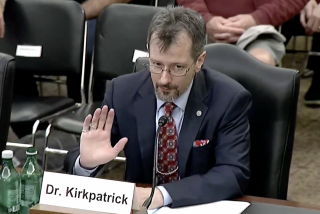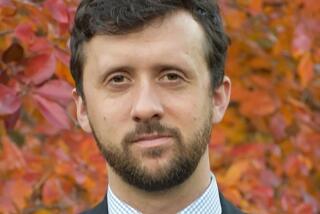. . . Now We Know Who Betrayed the U.S.
- Share via
The further away America gets from the era of McCarthyism, the more confusion about the events of that tortured decade become. Last Sunday, CNN ran the “Red Scare” episode of its much-heralded “Cold War” series, in which viewers heard that in both the Soviet Union and the United States, “the Cold War was fought by fear.” The Soviets had the Gulag, in which, as we know, millions perished, and the U.S. had J. Edgar Hoover and Joe McCarthy, proving to CNN that “both sides turned their own fear inward against their own people,” hunting “the enemy within.” Viewers heard actor Kenneth Branagh declaring that “the spirit of McCarthyism, the smearing of dissent as communist treason, stained American democracy for decades.”
The implication is clear: Both sides hunted witches and imprisoned dissenters. As in the Soviet Union, those accused by McCarthy and company in the U.S. were moral exemplars, innocent victims opposed because of their advocacy of peace, civil rights and political liberty.
It is time, as we look back at our past, that we face the truth about the real nature of American communists and how many of its cadre served the espionage apparatus of the Soviet Union. McCarthy, a classic demagogue, exploited popular fears and the nation’s inability to deal realistically and promptly with a very real threat to national security. McCarthy recklessly mixed the innocent with the guilty to serve his own political purposes and used evidence that he exaggerated and distorted and that often was totally false. But precisely because he was reckless, real communists who engaged in and contemplated espionage sought to claim the status of victims.
For example, CNN gives us the great African American athlete, actor and singer, the late Paul Robeson, as one major example. His career cut short in the 1950s because of the blacklist and his passport taken away, Robeson is shown as the victim of bloodthirsty mobs in Peekskill, N.Y., and as a premature fighter for civil rights at a moment when his right to perform as an artist was destroyed by the red-baiters. CNN also gave us the pro-communist lawyer Arthur Kinoy, who said that the great liberal jurist, Justice Jerome Frank, would have granted their effort to gain a new trial for Julius and Ethel Rosenberg except for the justice’s fear of what the McCarthyites would do to his career.
As for Robeson, as the historian William L. O’Neill has written, he “went around the world endorsing a political system based on mass murder, forced labor and the denial of every human right, accusing all who criticized him for doing so of bigotry.” A winner of the Stalin Peace Prize in 1952, Robeson made a lot of news when he told the House Un-American Activities Committee that in the case of war with the Soviet Union, black Americans would not fight. As for Kinoy, he never met a communist not worth defending and, although most Americans acknowledge that the death sentence handed down on the Rosenbergs was an abomination, unlike Kinoy, they know full well that Julius Rosenberg was a dedicated Soviet agent who provided the Soviets with whatever important information, including atomic data, that he could get his hands on.
As for the blacklist, its alumni are today cheered and honored in Hollywood, while the greatest American film director, Elia Kazan, continually gets turned down by Hollywood’s liberal elite, who refuse to grant him awards recognizing his contribution to American cinema because he cooperated with the HUAC by giving them names. As one of the blacklisted screenwriters recently put it, “You can’t separate Kazan’s work from what he did as a friendly witness.”
The movement the Hollywood left was part of was not composed of simple well-meaning, anti-fascist idealists. Rosenberg, Alger Hiss, Theodore Hall and others were not beleaguered “dissenters” who were arrested and persecuted for their ideas. They were conscious agents of a foreign power, the Soviet Union, who betrayed their own country. And there was no mass persecution of labor organizations or indictment of radical groups. Rather, hundreds of American communists who were spies were never identified or caught. The Communist Party, in fact, was not just another American political party at the time, operating according to the regularly established legal rules of political organizations, even though its tie to the Soviet Union defined its very raison d’etre, and it was as much a conspiracy as it was a group of independent-minded heretics.
Most Americans who spied for the Soviets, we now know, were members of the American Communist Party. And they composed a very serious threat to American national interests. Secret communists held high position in the U.S. government as well as key spots in the upper echelons of the Roosevelt administration. The Venona files--the record of Soviet cables broken by American code breakers--effectively prove that there was serious communist penetration of the government and that secret communists in Washington were passing on whatever information they could to their KGB contacts. The files prove that the Communist Party in the U.S. established secret caucuses in government agencies in the 1930s and ‘40s, seeking to influence their policies and steal confidential and classified documents. But a myth has arisen that anyone who linked American communists with Soviet espionage was a McCarthyite.
A bizarre feature of the myth is that those who actually betrayed the United States and assisted Stalin’s Soviet Union through espionage have become in the popular mind heroic victims. For example, Harry Dexter White, the assistant secretary of the Treasury and chief architect of the Bretton Woods agreement and the World Bank and first director of the International Monetary Fund, was not, as he claimed, one of the red-baiter’s victims but a Soviet agent regularly reporting to the KGB.
The fact is that quite a number of actually guilty individuals escaped any form of punishment. Soviet spies infiltrated the highest levels of the American government, from the State and Treasury departments to the Manhattan Project. As Sen. Daniel Patrick Moynihan (D-N.Y.) writes in his new book, “Secrecy,” “The U. S. government’s pursuit of alleged sympathizers and spies in the post-World War II period did not amount to persecution, still less delusion. Not a few in fact were spies, and of these, most were left untroubled.”


